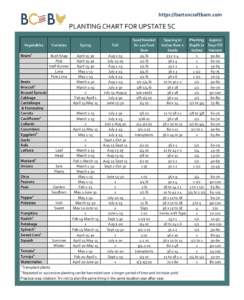WHEN IS BEST TO START YOUR GARDEN?
Is it time to plant the garden? Can you feel the pollen in the air? The locals around us all say it isn’t safe to plant a garden in the Upstate of SC until April 15th – little chance of frost after this date. That’s just the “rule”, there’s surely an exception from time to time. Here’s a guide of what to plant and when for our local area of the Upstate of SC.
Every planting zone will have different recommendations so figure out your gardening zone to estimate the first and last frost dates. Also, it’s good to find a local resource when you have a question or need help. Locally I would recommend Clemson Cooperative Extension with their Home & Garden Information Center. Most states should have something similar to reference.
If think you would like to start a garden from square one, I have listed a few steps to consider as you begin your grand garden plans. Don’t be discouraged if you have no garden knowledge, even the novice gardener can plant a successful backyard garden. I hope this information is helpful!
DECIDE WHAT YOU’D LIKE TO GROW
If you or someone in your family won’t eat a crop, don’t grow it in your vegetable garden. Make sure your top choices make sense for your gardening zone. If possible, talk to successful gardeners in your area to find out which crops grow well and which don’t.
Personally, we have planted tomatoes, peppers of many kinds, cucumbers, corn, butternut and summer squash, zucchini, beets, lettuce, basil, dill, and green beans. Those are the main crops in the big garden; it seems we do something a little different every year. A few times we tried onions, melons, broccoli, etc. Every year is an adventure.
Think about the size limitations of your garden, and plan accordingly. If you only want a small garden, don’t attempt to grow something like a giant pumpkin, or watermelons, which will spread over a very large area.
CHOOSE A LOCATION AND PLAN THE GARDEN
Most fruits and vegetables need full sun, with a minimum of five hours of direct sunlight per day for fruiting. greens, herbs, and root veggies will grow in partial shade.
Once you know where you want your garden, decide on the type and size of garden bed(s). Raised beds are attractive and may make it easier to work in your garden, but they also dry out more quickly. From our experience, and in very dry areas, sunken beds can be used to gather available moisture.
PREPARE THE SOIL
If you’re starting with sod, you’ll either need to cut it up in chunks and repurpose it, or till it in. We have quite a large garden so we have the tiller attachment on the tractor and also a rototiller that’s helpful later when weeds inevitably come, to clear the rows. If you are working on a small garden they make hand tillers that would be helpful for this step, and also some stores, like Home Depot, have rental tools for short periods of time and don’t want to store and service it.
Preparing the soil in the fall is best, but don’t let that stop you from starting in spring. Plants prefer a deep, well-drained, fertile soil rich in organic matter. Plant roots need good garden soil to produce good vegetables and fruit. Year after year the soil will morph into healthy soil.
We started out with South Carolina red clay and never thought anything would grow in it, but it actually did well, the plants adapted. Years after that first garden, with the yearly addition of fertilizer, growing things like wheatgrass in the off-season, and regular crop rotation, has helped the once red clay to now look like dark fertile soil.
You’ll want to add a combination of different types of organic matter, possibly including compost, cow manure, grass clippings, and mulch.
CHOOSE THE RIGHT SEEDS OR TRANSPLANTS
In general, we start our garden from seeds, with the exception of tomatoes and peppers. Usually we buy our plants and seeds at a local feed & seed store. Another great source for quality seeds online is the Vegetable Seed Warehouse. For the upstate of SC you can use the guide above in this section for the timing of when to plant your crops.
PLANTING AND MAINTAIN A GARDEN
Most seed packets will have very specific instructions on how deep and far apart to plant the crops. Wait until the danger of frost is past to plant heat-loving plants such as tomatoes, peppers, cucumbers, etc. Be careful with the transplants, as young plants are easier to damage.
Most plants need lots of water, so allot time for watering or have an irrigation system set up. Some systems can even be set to a timer. We just use our kids to change the water, we don’t want them getting bored over the long summer break!
If you’re not prepared to make time in your schedule to tend to your plants, you may be better off hitting the farmer’s market or sticking with extremely low maintenance items like sprouts or herbs. Depending on the size of your garden, time requirements may range from a few minutes per day to a full-time job.
I put together a list of my top garden tools to help the newbie get the needed gardening essentials. If you are getting started gardening, or want to be more prepared this season, check out the printable in my free resource library for my favorite garden tools to get your gardening on. Hope you enjoy!


